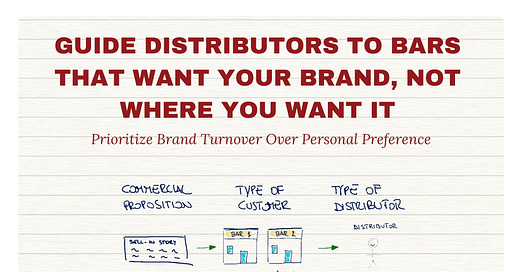Guide Distributors to Bars That Want Your Brand, Not Where You Want It
Prioritize Brand Turnover Over Personal Preference
The MAFFEO DRINKS Guides is a bi-weekly email newsletter. With a systematized approach, it helps drink builders grow their brand from 10 to 10k cases. Each edition solves one clear challenge for subscribers. Some editions are free, and others are paid. Sign up here
Dear Drinks Builder,
In today’s issue, I’ll discuss the importance of clearly guiding distributors to understand where to sell your brand.
By being clearer, you’ll likely increase your strike rate in the right outlets, and your distributor will see you as adding value instead of just asking to sell more.
Unfortunately, most brand owners think "clearer" means 100 pages on PowerPoint and are uselessly analytical.
Brand Owner - Distributor dynamics are always fascinating to me.
For many years, I represented brand owners. They were some of the biggest drinks companies in the world, and when I was trying to learn from internal best practices, they were always cocky.
They were based on the fact that if you represented a large company in a local market, distributors and on-trade customers had to listen to you.
That's what I thought until I realized I had a problem. I was working for newly established global brands. In the export department, the brands were only significant in the home market and a handful of others.
In the countries I was selling it, nobody knew my brands. I could not rely on an army of salespeople. Distributors only had a handful of them.
Those internal practices were useless because I didn't have the muscle that my brands had in those countries. Did I mention I had a tiny marketing budget, too?
So, I started developing my way of building brands from the bottom up, working the same way as craft brands.
After working with 30+ markets worldwide and talking with as many distributors as possible, I realized that most brand owners work top-down. They do so mainly in two ways:
1) A basic way of working that has not changed since last century: the brand owner signs a deal, sets ambitious targets, and beats the distributor every month for not reaching them.
2) Some others use a more sophisticated method, what I call "the wanna-be bottom-up": They give directions to local distributors on where they should sell their product, but they still do it top-down, without "boots on the ground."
They do so from the headquarters without walking the street, applying a one-size-fits-all approach. They tell the distributor to focus on the top cities and bars and maybe mention which types of outlets to sell to.
The problem is that all brands in that country get the same brief: the coolest bars in town.
The hard truth is that local teams know the right bars in their city, but they need clear guidance in understanding the right bar for the right occasion of a brand in a city.







